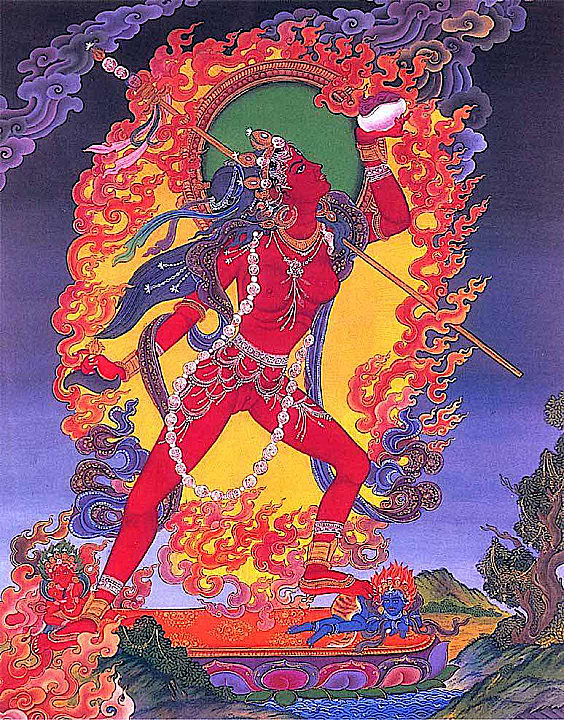
It was in 1996, in the Noe Valley Starbucks in San Francisco. I had just started a technology company. It consisted at the time of me, a linux laptop, and my stuffed hedgehog, who served as Chairman of the Board.
Two years earlier, I had started meditating seriously. I had begun reading about Tibetan Buddhism, and so I knew the story of Naropa’s dakini:
Naropa, immensely learned in scholastic arguments on the nature of emptiness, rose to the position of Chancellor of Nalanda University. One day on his way to teach in the central square of Rajagrha, an extraordinarily ugly woman stopped him as he walked through an open-air tea shop.
“Do you understand the words in those books you teach?” she demanded.
“I do,” he replied, slightly taken aback. He was the Chancellor of the greatest university in the world.
“And do you understand the meaning of the words?” she asked.
“I do…?” he said, wondering what this was about.
“You lie,” she said. “Your logic-chopping philosophy and your smarmy moral pieties are cemetery ash and musk-shrew’s dung. You can learn the meaning of empty form only by serving your teacher, Tilopa.” Fangs erupted from her face, and Naropa fell back, terrified, though it was midday in the busy marketplace.
The dakini spun into a pillar of black flame, then vanished with a sound like a mountain cracking.
“Bllbbth,” said Naropa, picking himself off the ground. He shook his head violently, wondering what had just happened.
Mind-stopped, he gazed vacantly at the green cotton awning of the tea shop for a minute, or for an hour. Then he handed his book bag to the barista at the counter, threw his gold-chased pen case into the gutter, and began walking west.
He had a vague but certain sense that “Tilopa,” whoever that was, must live somewhere upriver on the Ganges.
And the rest is history. Or legend, or myth… Naropa spent twelve years searching for Tilopa; then twelve years learning from him the meaning of Tantra: the electricity of empty form. The lineage recitation of the Kagyü School of Tibetan Buddhism begins: Tilopa, Naropa, Marpa (supposedly the first Tibetan), Milarepa (the evil sorcerer who repented and sang meaning into being)—and so forth. Whether any of those people actually existed is questionable, by the standards of Western historiography.
The dakini, on the other hand, did. I know, because I met her.
It was in 1996, in the Noe Valley Starbucks in San Francisco. I was sitting at a table facing the big front windows, working on the laptop.
She swaggered in, so large and loud without speaking that I looked up in surprise as she came through the door. She was looking right at me. She walked straight to my table and sat down opposite, grinning.
That she was homeless was obvious from her clothing; that she was crazy, from her demeanor.
Annoyed and slightly concerned, I became pointedly busy on the computer. Because I am pathologically introverted and entirely uninterested in the normal topics of conversation—interchangeably: politics, sports, and entertainer gossip—I had perfected the art of radiating omnidirectional, barely-polite hostility: communicating in body language, “I am important, occupied, and mean; if you interrupt, you’ll be very sorry.” This was almost invariably effective.
This schizophrenic street lady seemed to find my act extremely funny. She was watching me with a big unchanging amused smile. While pretending to work on the computer, I couldn’t help sneaking looks at her, because she was undoubtedly the ugliest person I had ever seen. I was uncomfortably aware that she was perfectly cognizant that I was checking her out. The dynamic was like that of sneaking glances at a woman I was hot for—and to my consternation I felt a baffling undercurrent of growing sexual attraction.
“Hah!” she said, much too loud.
My portrayal of a powerful professional performing programming intensified.
She giggled.
“You develop web sites…” she said.
I grunted and scowled. This was not going well. The don’t-fuck-with-me thing was not working.
“And I need a web site”, she said. “You are a Buddhist.”
I froze. How could she possibly know that? I gave an awkward half-nod, then caught myself.
In a good-humored conversational tone, she then told me everything of significance about myself. My insufferable intellectual arrogance and crushing loneliness. My impatience and contempt for humanity. My hopes for enlightenment and fantasies of becoming a famous spiritual teacher. The way my love life veered between years of deliberate celibacy and intense, frankly bizarre sexual relationships with improbable people. (She did not conceal that part of her intention for our future.) My fear of financial failure and my compulsive drive for success. My chronic depression and bafflement at being unable to make life work; and my joy at seeing the sky.
She went on for ten minutes, perhaps. My mouth half-open and my body tensed like I was facing a tigress, I cowered behind my laptop as a shield.
“So:” she concluded. “I do take students, you know. And I said I need a web site. We can work a deal—you do the web site, I take you as a student. For now.”
There are times when I will go with the logic of a surreal situation. Five years later, after selling the tech company and supposedly retiring, I found myself working as a waiter in the restaurant attached to a Hindu temple in Malaysia, due presumably to some causal chain that I could not begin to reconstruct. My ability to laugh and ecstatically enter into the flow (“I’ve no clue why how or why am I here, nor do I have the foggiest idea how to be a waiter in general, much less in a Malaysian Hindu temple restaurant, but I will do the absolute best job I can and enjoy it thoroughly, because why not”) seems to be the best measure of my health at the level of energy.
This was not one of those times.
I snapped closed the laptop without replying, and without looking at her; and I slipped it in my briefcase, and I ran like hell.
I worked in that Starbucks nearly every day. I never saw her again.

In fiction writing, your unconscious alchemically blends and transmutes daydreams and nightmares, and stories you have read or heard or watched, and people you’ve known, and memorable events from your history. A story tells itself; or more accurately the characters play it through, and you watch and listen and write it down. “And where did that come from,” you wonder. Repeatedly, I’ve discovered years later that I’d unwittingly stolen plot elements from Diane Duane, Ursula Le Guin, or Garth Nix. Or I realized in retrospect that a character was partly based on a particular person I knew long ago.
It was obvious from the beginning, though, that the central character in The Vetali’s Gift—although a composite—is mostly the same person I met in the Noe Valley Starbucks in 1996.
And the same person Naropa met in the Rajagrha tea shop in 1026.
My part of this story is true; or at least I have told it as accurately as I can remember what happened, a quarter century ago. I still have no idea what to make of it. Who was she? How did she do that? What would have happened to me if I had said yes? I cannot begin to imagine.
What happened for Naropa was unimaginable. The many versions of his story are variously fantastical and contradictory. In some, the dakini became his teacher after he left Tilopa. Some say she was a human woman; others, that she was the supernatural goddess Vajrayogini. Is that a contradiction? In Tantra, we see all women as supernatural goddesses.

Red in colour with one face, three eyes and two hands, her left holds aloft a human skull cup from which she sips frothing menstrual blood. Her right hand holds an iron kartika—a butcher’s hooked flaying-knife—with a golden vajra handle. She wears a tiara of skulls and a necklace of fifty freshly severed heads—each with a different expression. On an ornate sun disc and pink lotus seat she stands swathed in the flames of pristine awareness.
Unimaginable, yet someone imagined her; impossible, yet somehow true, and the innermost nature of every human being—male or female.
Including you. It was you who challenged me then; you who challenged Naropa’s academic understanding…
Myth has its own logic, which is truer than the absolute truths of the mathematical logic that Naropa learned from Dharmakirti’s textbook at Nalanda University.
